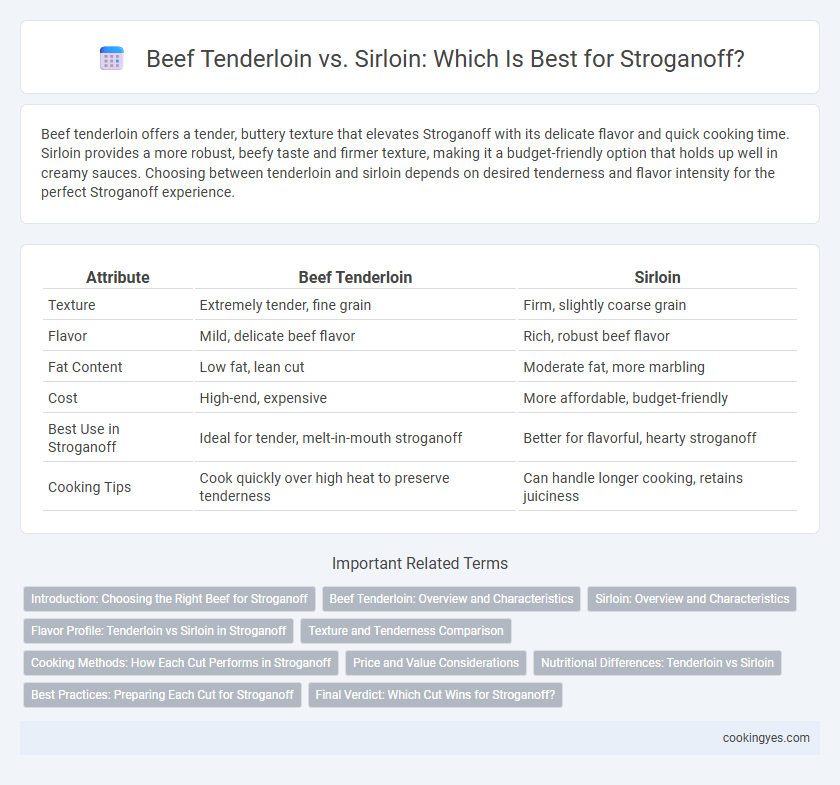Beef tenderloin offers a tender, buttery texture that elevates Stroganoff with its delicate flavor and quick cooking time. Sirloin provides a more robust, beefy taste and firmer texture, making it a budget-friendly option that holds up well in creamy sauces. Choosing between tenderloin and sirloin depends on desired tenderness and flavor intensity for the perfect Stroganoff experience.
Table of Comparison
| Attribute | Beef Tenderloin | Sirloin |
|---|---|---|
| Texture | Extremely tender, fine grain | Firm, slightly coarse grain |
| Flavor | Mild, delicate beef flavor | Rich, robust beef flavor |
| Fat Content | Low fat, lean cut | Moderate fat, more marbling |
| Cost | High-end, expensive | More affordable, budget-friendly |
| Best Use in Stroganoff | Ideal for tender, melt-in-mouth stroganoff | Better for flavorful, hearty stroganoff |
| Cooking Tips | Cook quickly over high heat to preserve tenderness | Can handle longer cooking, retains juiciness |
Introduction: Choosing the Right Beef for Stroganoff
Beef tenderloin offers exceptional tenderness and a mild flavor, making it ideal for Stroganoff's creamy sauce and quick cooking process. Sirloin provides a more robust beef flavor and firmer texture while remaining relatively tender, often preferred for a heartier Stroganoff dish. Selecting between tenderloin and sirloin depends on the desired balance of tenderness and flavor intensity in your Stroganoff recipe.
Beef Tenderloin: Overview and Characteristics
Beef tenderloin offers exceptional tenderness and a fine texture, making it ideal for Stroganoff where delicate, melt-in-your-mouth meat is desired. Its lean profile ensures a rich, buttery taste without excessive fat, enhancing the creamy sauce's flavor balance. While pricier than sirloin, tenderloin's premium quality elevates the dish with superior succulence and refined mouthfeel.
Sirloin: Overview and Characteristics
Sirloin is a popular choice for Stroganoff due to its balance of tenderness and flavor, offering a lean cut with moderate marbling that enhances juiciness when cooked quickly. It has a firmer texture compared to beef tenderloin but retains enough tenderness to absorb the creamy sauce characteristic of Stroganoff. Rich in protein and lower in fat than ribeye, sirloin provides a cost-effective option without sacrificing the dish's signature taste and mouthfeel.
Flavor Profile: Tenderloin vs Sirloin in Stroganoff
Beef tenderloin offers a mild, buttery flavor and an exceptionally tender texture that enhances Stroganoff's creamy sauce, creating a luxurious mouthfeel. Sirloin delivers a more robust, beefy taste with slightly firmer texture, providing a pronounced meatiness that balances the dish's richness. Choosing between tenderloin and sirloin for Stroganoff ultimately depends on desired flavor intensity and tenderness preferences.
Texture and Tenderness Comparison
Beef tenderloin offers exceptional tenderness and a fine, buttery texture that melts in the mouth, making it ideal for Stroganoff's creamy sauce. Sirloin provides a firmer texture with more pronounced beefy flavor, resulting in a slightly chewier bite that holds up well during cooking. Choosing tenderloin enhances the dish's smoothness, while sirloin adds robustness and a satisfying chew to the Stroganoff experience.
Cooking Methods: How Each Cut Performs in Stroganoff
Beef tenderloin's tender texture allows it to quickly absorb the creamy Stroganoff sauce without becoming tough, making it ideal for sauteing at high heat with minimal cooking time. Sirloin, slightly less tender but more flavorful, performs well when sliced thinly and cooked gently over medium heat to avoid toughness while building a rich, beefy base for the dish. Both cuts benefit from searing to develop a savory crust, but tenderloin requires precise timing to maintain its buttery softness, whereas sirloin can withstand longer cooking for deeper flavor infusion.
Price and Value Considerations
Beef tenderloin is premium-priced due to its exceptional tenderness and fine texture, making it ideal for luxurious Stroganoff dishes but less cost-effective for large servings. Sirloin offers a balanced price-to-value ratio with good tenderness and robust flavor, making it a popular and economical choice for everyday Stroganoff recipes. Choosing between tenderloin and sirloin depends on budget constraints and the desired quality level, influencing overall meal cost and satisfaction.
Nutritional Differences: Tenderloin vs Sirloin
Beef tenderloin contains fewer calories and less fat compared to sirloin, making it a leaner option for Stroganoff. Sirloin offers higher protein content and more iron, contributing to greater nutritional density. Choosing between tenderloin and sirloin affects the dish's overall fat content and micronutrient profile, influencing both flavor and health benefits.
Best Practices: Preparing Each Cut for Stroganoff
Beef tenderloin offers a tender, buttery texture ideal for Stroganoff, requiring minimal cooking time to maintain its juiciness and delicate flavor. Sirloin, with its firmer texture and richer beefy taste, benefits from thin slicing against the grain and marinating to enhance tenderness before quick sauteing over high heat. Both cuts should be cooked swiftly to medium-rare to prevent toughness and ensure optimal flavor absorption in the creamy Stroganoff sauce.
Final Verdict: Which Cut Wins for Stroganoff?
Beef tenderloin offers unparalleled tenderness, making Stroganoff exceptionally smooth and luxurious, while sirloin brings a richer, more pronounced beef flavor with a firmer texture. For a classic Stroganoff that balances tenderness and flavor without breaking the bank, sirloin is often preferred due to its affordability and robust taste. Selecting sirloin ensures a satisfying Stroganoff experience with a perfect harmony of texture and rich beefiness.
Beef tenderloin vs sirloin for Stroganoff meat Infographic

 cookingyes.com
cookingyes.com